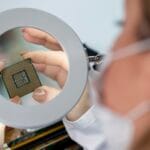Images and visual data are essential in a variety of applications today, from surveillance and medical imaging to robots and driverless vehicles. FPGA (Field-Programmable Gate Array) technology can provide the robust processing capabilities needed to extract useful information from these images.
A cutting-edge method for addressing the computing difficulties involved in real-time image analysis and manipulation is FPGA-based Image Processing and Computer Vision.
FPGAs are programmable integrated circuits that can be efficiently programmed to carry out particular tasks. FPGAs are excellent at parallel processing, making them perfect for image processing and computer vision applications, in contrast to conventional processors like CPUs or GPUs, which carry out sequential instructions.
Developers can speed up image processing methods, improve performance, and attain real-time outcomes by utilizing the hardware parallelism and adaptability of FPGAs.
Basics of Image Processing:
It is crucial to gain a fundamental understanding of image processing before diving into FPGA-based image processing. Image processing is the practice of modifying and analyzing photographs in order to improve their quality, draw out important details, or facilitate automated decision-making. Increasing image visibility, eliminating noise or artifacts, segmenting items of interest, and extracting pertinent features are some of the objectives of image processing.
To comprehend FPGA-based image processing, it is crucial to grasp the fundamental concepts and techniques used in this field. Some of the key aspects to explore are:
- Definition of image processing: Provide a concise definition of image processing and its significance in various domains. Explain how image processing techniques can unlock valuable insights from visual data.
- Common image processing operations: Introduce and explain frequently used image processing operations, such as filtering (e.g., noise reduction filters, edge enhancement filters), enhancement (e.g., contrast adjustment, color correction), and segmentation (e.g., region-based segmentation, edge-based segmentation). Illustrate these operations with examples and discuss their applications.
- Image formats: Describe different image formats commonly used in digital image processing, such as JPEG, PNG, and TIFF. Explain their characteristics, including color spaces (e.g., RGB, grayscale), bit depth, and compression techniques. Discuss the impact of image formats on FPGA-based image processing.
By understanding the basics of image processing, readers will gain a solid foundation for exploring how FPGA technology can accelerate and optimize these operations for efficient image analysis.
FPGA in Image Processing:
In this section, we will delve into the advantages of using FPGAs for image processing tasks and compare them to other hardware platforms like CPUs and GPUs. Key points covered include:
- Advantages of FPGA for image processing: Highlight the specific strengths of FPGAs in image processing applications, such as their parallel processing capabilities, low latency, and reconfigurability. Explain how these features make FPGAs well-suited for real-time image processing tasks.
- Comparison with CPUs and GPUs: Provide a comparison between FPGAs, CPUs, and GPUs in terms of performance, power consumption, and flexibility for image processing tasks. Discuss scenarios where FPGAs outperform other platforms and the unique benefits they offer.
- FPGA architecture for image processing: Introduce the architecture of FPGAs and explain how it facilitates efficient image processing. Discuss key components like lookup tables (LUTs), flip-flops, block RAM, and DSP slices, and their roles in executing image processing algorithms in parallel.
By understanding the advantages and architectural considerations of FPGA technology, readers will gain insight into why FPGAs are increasingly being adopted for image-processing applications.
FPGA Implementation of Image Processing Algorithms:
Now that we have established the foundation, we can explore the implementation of image-processing algorithms on FPGAs. Some key points to cover are:
- Image processing algorithms in computer vision: Provide an overview of common image processing algorithms used in computer vision applications, such as edge detection, image segmentation, feature extraction, and object recognition. Explain the significance of these algorithms for various computer vision tasks.
- FPGA implementation considerations: Discuss the specific considerations and challenges involved in implementing image processing algorithms on FPGAs. Explore topics such as data parallelism, memory optimization, algorithm pipelining, and resource allocation.
Computer Vision on FPGA:
In this section, we shift our focus to computer vision, which encompasses the extraction, analysis, and understanding of visual information. We will explore how FPGA technology can be leveraged for computer vision tasks. Key points covered include:
- Introduction to computer vision: Provide an overview of computer vision and its significance in various domains, such as autonomous vehicles, robotics, surveillance, and healthcare. Explain how computer vision algorithms enable machines to perceive and interpret visual data.
- Key computer vision algorithms: Discuss popular computer vision algorithms, including object detection, image recognition, optical flow, and stereo vision. Explain the principles behind these algorithms and their applications in real-world scenarios.
- Challenges and benefits of FPGA-based computer vision: Highlight the specific challenges and considerations in implementing computer vision algorithms on FPGAs. Discuss the benefits of FPGA technology for computer vision, such as high parallelism, low latency, and real-time performance.
Conclusion:
In conclusion, FPGA-based Image Processing and Computer Vision offer a compelling approach to addressing the computational challenges inherent in analyzing and interpreting visual data. By harnessing parallel processing capabilities, low latency, And reconfigurability of FPGAs, developers can accelerate image processing algorithms, enhance performance, and achieve real-time results in a wide range of applications.
Throughout this blog post, we have explored the foundations of image processing, understanding its goals, and common operations. We also delved into the advantages of FPGA technology for image processing and compared it to other hardware platforms. Additionally, we discussed the implementation of image processing algorithms on FPGAs and showcased real-world case studies that demonstrate the successful application of FPGA-based image processing and computer vision.


![What is FPGA Introduction to FPGA Basics [2023] computer-chip-dark-background-with-word-intel-it](https://fpgainsights.com/wp-content/uploads/2023/06/computer-chip-dark-background-with-word-intel-it-300x171.jpg)









